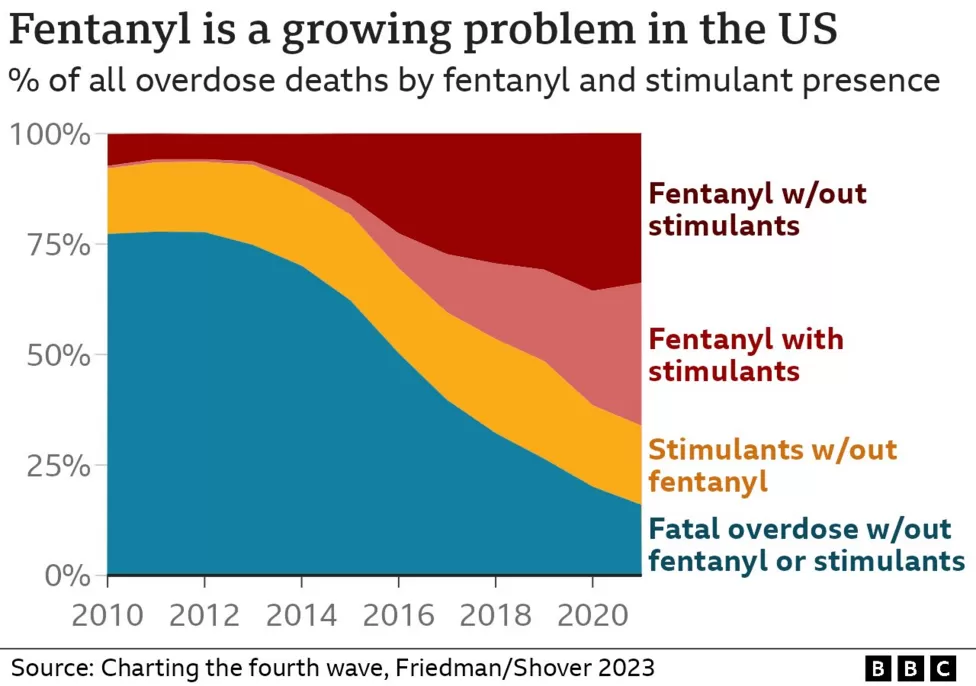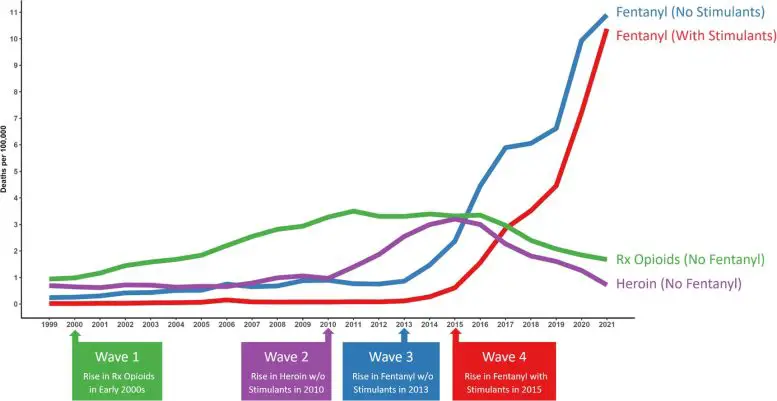News
The Lethal Surge: Fentanyl’s Deadly Role In The ‘4th Wave’ Of The U.S. Overdose Crisis

(CTN NEWS) – The emergence of this trend marks the fourth wave of the ongoing overdose crisis in the United States.
This crisis originally began in the early 2000s with a surge in prescription opioid-related deaths and has since evolved to encompass a broader range of substances.
A recent study led by UCLA has revealed a staggering increase in the percentage of overdose deaths in the United States involving both fentanyl and stimulants.
This percentage has surged more than 50-fold since 2010, skyrocketing from a mere 0.6% (accounting for 235 deaths) in 2010 to a distressing 32.3% (resulting in 34,429 deaths) in 2021.
By 2021, stimulants like cocaine and methamphetamine had become the predominant drug class found in fentanyl-related overdoses across every state in the US.
This dramatic rise in fatalities associated with the combination of fentanyl and stimulants constitutes what experts are referring to as the ‘fourth wave’ in the United States’ protracted opioid overdose crisis, a crisis that continues to claim an escalating number of lives.
Rapid Emergence of Fentanyl-Stimulant Combinations: A Grave Challenge in the Ongoing US Overdose Crisis
Joseph Friedman, the lead author of the study and an addiction researcher at the David Geffen School of Medicine at UCLA, emphasized the gravity of this shift, stating, “We are witnessing a rapid shift towards fentanyl combined with stimulants as the dominant factor driving the overdose crisis in the United States.
Fentanyl has introduced a complex problem of polysubstance overdose, where individuals are mixing fentanyl not only with stimulants but also with numerous other synthetic substances.
This presents a multitude of health risks and poses new challenges for healthcare providers.
While we possess data and medical expertise in treating opioid use disorders, we have relatively limited experience in addressing the simultaneous use of opioids and stimulants, or opioids combined with other drugs.
This complexity makes it challenging to provide effective medical stabilization for individuals withdrawing from the use of multiple substances.”
These findings, published on September 13 in the peer-reviewed journal Addiction, underscore the urgent need for comprehensive and adaptable strategies to combat this evolving public health crisis.
Opioid Crisis Chronology Unfolded
The timeline of the opioid crisis in the United States unfolds as follows: It commenced with a surge in fatalities attributed to prescription opioids (wave 1) in the early 2000s, followed by heroin-related deaths (wave 2) in 2010.
Around 2013, an alarming spike in fentanyl-related overdoses marked the onset of the third wave. Subsequently, the fourth wave emerged in 2015, characterized by a growing prevalence of fentanyl overdoses combined with stimulants.
Adding a layer of complexity to the crisis is the fact that individuals who consume multiple substances are at heightened risk of overdose. Furthermore, many substances mixed with fentanyl do not respond to naloxone, the antidote for opioid overdoses.
Demographic and Geographic Patterns
The research also highlights stark demographic disparities in fentanyl/stimulant overdose deaths, with a disproportionate impact on racial and ethnic minority communities in the United States, including Black and African American individuals as well as Native American populations.
For example, in 2021, the prevalence of stimulant involvement in fentanyl overdose deaths reached 73% among Non-Hispanic Black or African American women aged 65 to 74 residing in the western US and 69% among Black or African American men aged 55 to 65 in the same region.
In contrast, the rate among the general US population in 2021 stood at 49%.
Moreover, geographical patterns in fentanyl/stimulant use have emerged. In the northeastern US, fentanyl tends to be combined with cocaine, whereas in the southern and western regions, it is most frequently encountered alongside methamphetamine.
Joseph Friedman, one of the study’s authors, offers insight into this geographical variation, suggesting that it may reflect the increasing availability of low-cost, high-purity methamphetamine across the country.
He also notes the persistence of illicit cocaine use in the Northeast, which has resisted the complete shift to methamphetamine seen in other parts of the nation.
RELATED CTN NEWS:
Imran Khan Appeals For Post-Arrest Bail In Cipher Case Following Rejected Plea
Ken Paxton’s Resounding Acquittal: GOP’s Hard-Right Victory In Historic Impeachment Trial
[WATCH] Iran Experiences Unprecedented Protests On 1st Anniversary Of Mahsa Amini’s Tragic Death





























